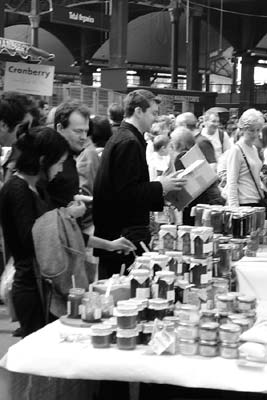
FANCY DEPARTMENT STORES IN WEST LONDON
Map: Regent Street Shopping Walk
London is great for shoppers—and, thanks to the high prices, perhaps even better for window-shoppers. This chapter will tell you where to get essentials, where to get souvenirs, where to browse through colorful street markets, and where to gawk at some high-end stores in this major fashion capital.
Most stores are open Monday through Saturday from roughly 9:00 or 10:00 until 17:00 or 18:00, with a late night on Wednesday or Thursday (usually until 19:00 or 20:00). Many close on Sundays. Large department stores stay open later during the week (until about 21:00 Mon-Sat) with shorter hours on Sundays.
Consider these tips for shopping in London:
• If all you need are souvenirs, a surgical strike at any souvenir shop will do.
• London’s museums have extraordinarily good shops. The Transport Museum’s is one of the best, and stays open at least a half-hour later than the museum itself (listed on here ). Other sights with great shops include the British Museum (here ), the National Gallery (here ), the Victoria and Albert Museum (here ), the Museum of London (here ), the National Portrait Gallery (here ), the Tate Modern (here ), and the wacky selections at Pollock’s Toy Museum (here ) and the Old Operating Theatre (here ).
• Large department stores offer relatively painless one-stop shopping. Consider the down-to-earth Marks & Spencer (Mon-Sat 9:00-21:00, Sun 12:00-18:00, 173 Oxford Street, Tube: Oxford Circus; another at 458 Oxford Street, Tube: Bond Street or Marble Arch; see www.marksandspencer.com for more locations).
• For flea-market fun and bargains, try one of the many street markets.
• Gawkers as well as serious bidders can attend high-end auctions.
For information on VAT refunds and customs regulations, see here . Refuse any offers to charge your credit card in dollars. This is called dynamic currency conversion (DCC), and it’s offered by some stores (including Harrods) as a “convenience.” The very bad exchange rate they use is convenient only for increasing the store’s profits.
London is famous for its shopping. The best and most convenient shopping streets are in the West End and West London (roughly between Soho and Hyde Park). You’ll find midrange shops along Oxford Street (running east from Tube: Marble Arch), and fancier shops along Regent Street (stretching south from Tube: Oxford Circus to Piccadilly Circus) and Knightsbridge (where you’ll find Harrods and Harvey Nichols; Tube: Knightsbridge). Other streets are more specialized, such as Jermyn Street for old-fashioned men’s clothing (just south of Piccadilly Street) and Charing Cross Road for books. Floral Street, connecting Leicester Square to Covent Garden, is lined with fashion boutiques. My “Regent Street Shopping Walk,” at the end of this chapter, connects several shopping areas, including Oxford, Regent, Carnaby, and Jermyn streets.
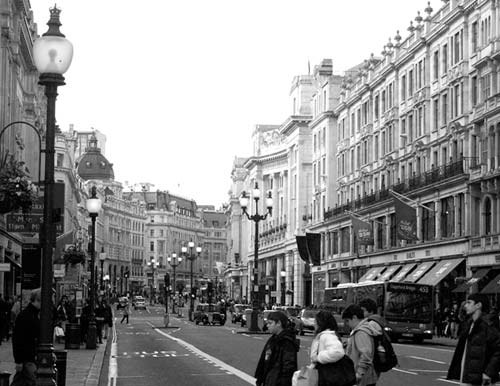
Harrods is London’s most famous and touristy department store. With more than four acres of retail space covering seven floors, it’s a place where some shoppers could spend all day. (To me, it’s still just a department store.) Big yet classy, Harrods has everything from elephants to toothbrushes (Mon-Sat 10:00-21:00, Sun 11:30-18:00; baggage check outside on Basil Street—follow left luggage signs at back of the store, a hefty £25/bag; Brompton Road, Tube: Knightsbridge, tel. 020/7730-1234, www.harrods.com ).
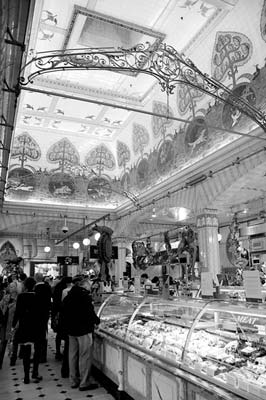
Sightseers should pick up the free Store Guide at any info post. Here’s what I enjoy: On the ground floor, find the Food Halls, with their Edwardian tiled walls, creative and exuberant displays, and staff in period costumes—not quite like your local supermarket back home.
Descend to the lower ground floor (fewer crowds) and follow signs to the Egyptian Escalator (in the center of the store). Here you’ll find a memorial to Princess Diana and her boyfriend, Dodi Fayed, who both died in a car crash in Paris in 1997 (Dodi’s father, Mohamed Al Fayed, was the store’s former owner). Photos and flowers honor the late princess and her lover. Inside a small, clear pyramid, you can see a wine glass still dirty from their last dinner and the engagement ring that Dodi purchased the day before they died. True Di-hards can even sign the official condolence book. A huge (and more than a little creepy) bronze statue shows Di and Dodi releasing a symbolic albatross.
Ride the Egyptian Escalator—lined with pharaoh-headed sconces, papyrus-plant lamps, and hieroglyphic balconies—to the third floor. From the escalator, turn right, then immediately left, and head to the far end to find the incredible Toy Land, which includes an impressive Harry Potter section (wands go for upwards of £100), and child-size luxury pedal cars (£7,000)—the perfect gift for the child who has everything.
More than two dozen eateries are scattered throughout the store, including a sushi bar, deli, pizzeria, Ladurée macaron parlor, and—for the truly homesick—an American burger bar.
Many of my readers report that Harrods is overpriced, snooty, and teeming with American, Japanese, and Middle Eastern tourists with zero concept of bargain shopping. It’s the only shopping mall I’ve seen with its own gift store. Still, it’s the palace of department stores.
Once Princess Diana’s favorite and later Duchess Kate’s, “Harvey Nick’s” remains the department store du jour (Mon-Sat 10:00-20:00, Sun 11:30-18:00, near Harrods, 109 Knightsbridge, Tube: Knightsbridge, tel. 020/7235-5000, www.harveynichols.com ). Want to pick up a £20 scarf? You won’t do it here, where they’re more like £200. The store’s fifth floor is a veritable food fest, with a gourmet grocery store, a fancy restaurant, a Yo! Sushi bar, and a lively café. Consider a takeaway tray of sushi to eat on a bench in the Hyde Park rose garden two blocks away.
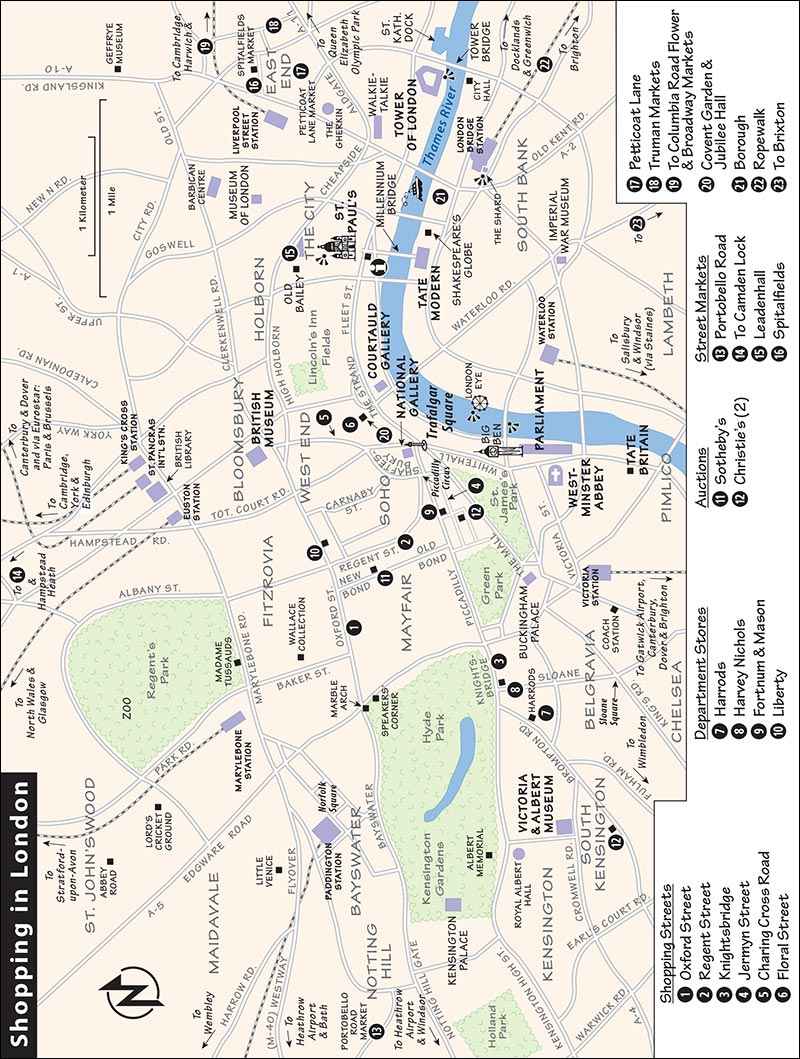
The official department store of the Queen, Fortnum & Mason embodies old-fashioned, British upper-class taste. While some feel it is too stuffy, you won’t find another store with the same storybook atmosphere. With rich displays and deep red carpet, Fortnum’s feels classier and more relaxed than Harrods. The Queen, Camilla, and Kate—three generations of royalty—enjoyed tea here together in 2012 (Mon-Sat 10:00-21:00, Sun 11:30-18:00, elegant tea served in their Diamond Jubilee Tea Salon—see here , 181 Piccadilly, Tube: Green Park, tel. 020/7734-8040, www.fortnumandmason.com ; also see the “Regent Street Shopping Walk,” later).
Designed to make well-heeled shoppers feel at home, this half-timbered, mock-Tudor emporium is a 19th-century institution that thrives today. Known for its gorgeous “Liberty Print” floral fabrics, well-stocked crafts department, and castle-like interior, this iconic shop was a favorite of writer Oscar Wilde, who called it “the chosen resort of the artistic shopper” (Mon-Sat 10:00-20:00, Sun 12:00-18:00, Great Marlborough Street, Tube: Oxford Circus, tel. 020/7734-1234, www.liberty.co.uk , also see the “Regent Street Shopping Walk,” later).
Antique buffs, people-watchers, and folks who brake for garage sales love London’s street markets. There’s good early-morning market activity somewhere any day of the week. The best markets—which combine lively stalls and a colorful neighborhood with cute and characteristic shops of their own—are Portobello Road and Camden Lock Market. Hagglers will enjoy the no-holds-barred bargaining encouraged in London’s street markets.
Warning: Markets attract two kinds of people—tourists and pickpockets.
Arguably London’s best street market, Portobello Road stretches for several blocks through the delightful, colorful, funky-yet-quaint Notting Hill neighborhood. Already-charming streets lined with pastel-painted houses and offbeat antique shops are enlivened on Fridays and Saturdays with 2,000 additional stalls (9:00-19:00), plus food, live music, and more. (The best strategy is to come on Friday; most stalls are open, with half the crowds of Saturday.) If you start at Notting Hill Gate and work your way north, you’ll find these general sections: antiques, new goods, produce, vintage clothing, more new goods, a flea market, and more food. While Portobello Road is best on Fridays and Saturdays, it’s enjoyable to stroll this street on most other days as well, since the quirky shops are fun to explore (Tube: Notting Hill Gate, near recommended accommodations, tel. 020/7727-7684, www.portobelloroad.co.uk ).
This huge, trendy arts-and-crafts festival is divided into three areas, each with its own vibe (but all of them fresh and funky). The whole complex sprawls around an old-fashioned, still-functioning lock (used mostly for leisure boats) and its retro-chic, yellow-brick industrial buildings. The main market, set alongside the picturesque canal, features a mix of shops and stalls selling boutique crafts and artisanal foods. The market on the opposite side of Chalk Farm Road is edgier, with cheap ethnic food stalls, lots of canalside seating, and punk crafts. The Stables, a sprawling, incense-scented complex, is decorated with fun statues of horses and squeezed into tunnels under the old rail bridge just behind the main market. It’s a little lowbrow and wildly creative, with cheap clothes, junk jewelry, and loud music (daily 10:00-18:00, busiest on weekends, tel. 020/3763-9999, www.camdenlockmarket.com ).
To escape the crowds, stroll for a while in either direction along the tranquil canal; it’s possible to walk east from here all the way to Queen Elizabeth Olympic Park in Stratford (about six miles away).
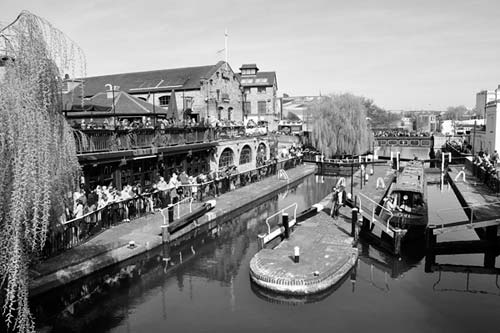
Arriving by Tube, avoid the tacky, crowded area between the market and the Camden Town Tube station (which bills itself as “The Camden Market,” but lacks the real one’s canalside charm) by getting off at the Chalk Farm stop. Better yet, arrive via a scenic waterbus ride from Little Venice: Consider London Waterbus Company (tel. 020/7482-2660, www.londonwaterbus.com ), Jason’s Trip (www.jasons.co.uk ), or the Jenny Wren (tel. 020/7485-4433, www.walkersquay.com ). Bus #24 heads from Pimlico to Victoria Station to Trafalgar Square and then straight up to Camden, before continuing on to Hampstead Heath.
One of London’s oldest, Leadenhall Market stands on the original Roman center of town. Today, cheese and flower shops nestle between pubs, restaurants, and fashion boutiques, all beneath a beautiful Victorian arcade (Harry Potter fans may recognize it as Diagon Alley). This is not a “street market” in the true sense, but more a hidden gem in the midst of London’s financial grind (Mon-Fri 10:00-18:00, closed Sat-Sun, tel. 020/7332-1523, Tube: Monument or Liverpool; off Gracechurch Street near Leadenhall Street and Fenchurch).
Most of these East End markets are busiest and most interesting on Sundays; the Broadway Market is best on Saturdays. For a walk tying together several of these markets—and a lot more in this neighborhood, which combines Cockney memories with London’s biggest Bangladeshi community—see here .
This huge, mod-feeling market hall (pronounced “spittle-fields”) combines a shopping mall with old brick buildings and sleek modern ones, all covered by a giant glass roof. The shops, stalls, and a rainbow of restaurant options are open every day, tempting you with ethnic eateries, crafts, trendy clothes, bags, and an antiques-and-junk market (Mon-Fri 10:00-17:00, Sat 11:00-17:00, Sun 9:00-17:00, Tube: Liverpool Street; from the Tube stop, take Bishopsgate East exit, turn left, walk to Brushfield Street, and turn right; www.spitalfields.co.uk ).
Just a block from Spitalfields Market, this line of stalls sits on the otherwise dull, glass-skyscraper-filled Middlesex Street; adjoining Wentworth Street is grungier and more characteristic. Expect budget clothing, leather, shoes, watches, jewelry, and crowds (Sun 9:00-14:00, sometimes later; smaller market Mon-Fri on Wentworth Street only; closed Sat; Middlesex Street and Wentworth Street, Tube: Liverpool Street).
Housed in the former Truman Brewery on Brick Lane, this cluster of markets is in the heart of the “Banglatown” Bangladeshi community. Of the East End market areas, these are the grittiest and most avant-garde, selling handmade clothes and home decor as well as ethnic street food. The markets are in full swing on Sundays (roughly 10:00-17:00), though you’ll see some action on Saturdays (11:00-18:00). The Boiler House Food Hall and the Backyard Market (hipster arts and crafts) go all weekend—and the Vintage Market (clothes) even operates on Thursdays and Fridays (11:00-17:30). Surrounding shops and eateries, including a fun courtyard of food trucks tucked off Brick Lane, are open all week (Tube: Liverpool Street or Aldgate East, tel. 020/7770-6028, www.bricklanemarket.com ).
From the Truman Brewery complex, Brick Lane is lined with Sunday market stalls all the way up to Bethnal Green Road, about a ten-minute walk. Continuing straight (north) about five more minutes takes you to Columbia Road, where you can turn right (east) to find a colorful shopping street made even more so by the Sunday-morning commotion of shouting flower vendors. The prices are good (why not brighten up your hotel room with a bouquet?), and the sales pitches are entertaining (Sun 8:00-15:00, closed Mon-Sat, http://columbiaroad.info ). Halfway up Columbia Road, be sure to loop left up little Ezra Street, with characteristic eateries, boutiques, and antique vendors.
While the other listed East End markets are best on Sundays, Saturdays are best for the festive market sprawling through this aptly named neighborhood—ground zero for London’s hipsters. A bit farther out, this market can be tricky to reach; it’s easiest to take the Overground from Liverpool Street Station three stops to London Fields, then walk through that park to the market.
Several blocks are filled with foodie delights, along with a few arts and crafts. The Broadway Schoolyard section is home to popular food trucks—many of them satellites of brick-and-mortar restaurants spread across London—selling trendy, affordable bites. The lineup changes constantly, but if you happen to see Dumpling Shack, Shrimpy, or The Frenchie, you know you came on a good day (Sat 9:00-17:00, closed Sun-Fri, www.broadwaymarket.co.uk ).
On sunny days, the London Fields park just north of the market is filled with thousands of picnicking and sunbathing locals enjoying their little slice of the city.
Originally the convent garden for Westminster Abbey, the iron-and-glass market hall hosted a produce market until the 1970s (earning it the name “Apple Market”). Now it’s a mix of fun shops, eateries, markets, and—thanks to Steve Jobs—a more modern-day Apple store on the corner. Mondays are for antiques, while arts and crafts dominate the rest of the week. Yesteryear’s produce stalls are open daily 10:30-18:00, and on Thursdays, a food market brightens up the square (Tube: Covent Garden, tel. 020/7395-1350, www.coventgardenlondonuk.com
, also see  West End Walk).
West End Walk).
Located on the south side of Covent Garden, this market features antiques on Mondays; a general market Tuesday through Friday; and arts and crafts on Saturdays and Sundays (Mon 5:00-17:00, Tue-Fri 10:30-19:00, Sat-Sun 10:00-18:00, tel. 020/7379-4242, www.jubileemarket.co.uk ).
London’s oldest fruit-and-vegetable market has been serving the Southwark community for over 800 years. These days there are as many people taking photos as buying fruit, cheese, and beautiful breads, but it’s still a fun carnival atmosphere with fantastic stall food. For maximum market and minimum crowds, join the locals on Thursdays (full market open Wed-Thu 10:00-17:00, Fri 10:00-18:00, Sat 8:00-17:00, closed Sun-Tue; surrounding food
stalls open daily; south of London Bridge, where Southwark Street meets Borough High Street; Tube: London Bridge, tel. 020/7407-1002, www.boroughmarket.org.uk
, also see  Bankside Walk).
Bankside Walk).
This short-but-sweet, completely untouristy food bazaar bustles on weekends under a nondescript rail bridge in the shadow of the Shard. Two dozen vendors fill the narrow passage with a festival of hipster/artisan food carts, offering everything from gourmet burgers to waffles to scotch eggs to ice-cream sandwiches. Come as hungry as possible and graze your way to a satisfying lunch (Sat 9:00-16:00, Sun 11:00-16:00, www.maltby.st ). This area of South London—called Bermondsey—is a lowbrow but emerging neighborhood that’s fun to explore for a slice of youthful, untrampled city. A short walk southeast of Tower Bridge, it has several rustic microbreweries tucked between self-storage shops and auto-repair garages.
This seedy neighborhood south of the Thames features yet another thriving market. Here the food, clothing, records, and hair-braiding throb with an Afro-Caribbean beat (shops and stalls open Mon-Sat 8:00-18:00, Wed until 15:00, farmers market Sun 10:00-14:00 but otherwise dead on Sun; Tube: Brixton, www.brixtonmarket.net ).
With several sightseeing treats just a quick DLR ride from central London, Greenwich has its share of great markets, especially lively on weekends. For details, see here .
London’s famous auctioneers welcome the curious public for viewing and bidding. You can preview estate catalogs or browse auction calendars online. To ask questions or set up an appointment, contact Sotheby’s (opening times vary, tel. 020/7293-5000, www.sothebys.com ; recommended café on site, 34 New Bond Street, Tube: Oxford Circus) or Christie’s (Mon-Fri 9:00-17:00; 85 Old Brompton Road, Tube: South Kensington, tel. 020/7930-6074; second location at 8 King Street, Tube: Green Park, tel. 020/7839-9060; www.christies.com ).
(See "Regent Street Shopping Walk" map, here .)
This mile-long walk—along Regent Street to Piccadilly Circus, then up the street called Piccadilly and down Jermyn Street—takes you by the most typically London stores and shops. While useful for true shoppers, this walk is also a lot of fun for window-shoppers. Only you know how much time—and money—to allow for this walk.
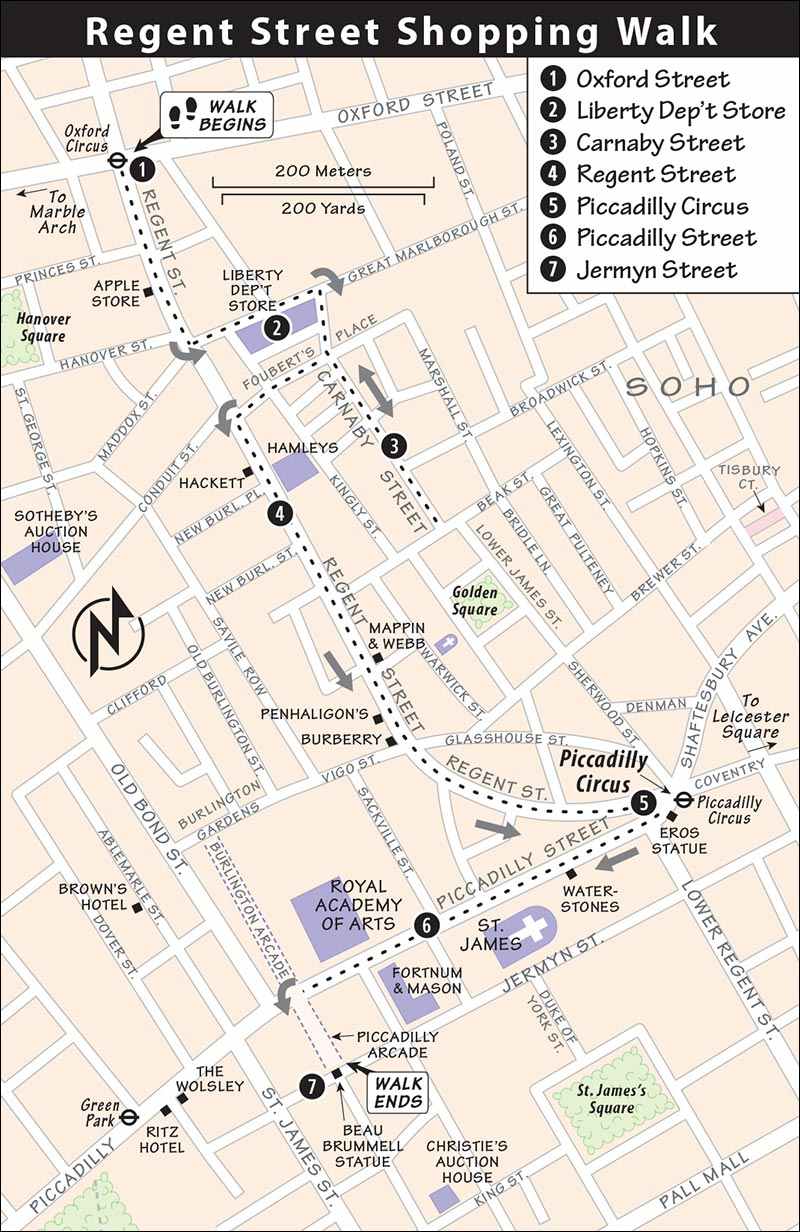
• Start your walk at the Oxford Circus Tube stop.
 Oxford Street
Oxford Street
Today, Oxford Street is a midrange shopping area, lined by less-distinguished chains and department stores, and a bit scruffy. But it was once one of London’s great shopping streets, and is still one of the most decorative at Christmastime. The original Selfridges (250 yards west of Oxford Circus), opened in 1910, helped pioneer the modern concept of the department store.
• From the Oxford Circus Tube stop, head south on Regent Street (heading slightly downhill, away from the steeple in the road). Stay along the left (east) side of Regent Street. Two blocks down, where Regent crosses Great Marlborough Street, look left to spot...
 Liberty Department Store
Liberty Department Store
The venerable Liberty is a big, stately, local-favorite department store established in 1875. Its distinctive faux-Tudor building was constructed from the timbers of two decommissioned Royal Navy battleships; for more information, see here .
Before moving on, note the nearby Apple Store—it’s behind you, a half-block up from Liberty at #235 Regent Street. The building looks more like a palace. It’s popular with tourists who appreciate its free Wi-Fi...and Londoners who are astounded by its customer service. The English are capable of good service too, but, as a Londoner put it to me, “not the obsequious butt-kissing some Americans expect, because that makes you feel like a servant.”
• Turn left on Great Marlborough Street, go past Liberty, and turn right onto...
 Carnaby Street
Carnaby Street
In the Swinging ’60s, when Pete Townshend needed a paisley shirt, John Lennon a Nehru jacket, or Twiggy a miniskirt, they came here—where those mod fashions were invented. If you were a “Dedicated Follower of Fashion” (as a Kinks’ song put it), you were one of the trendy “Carnaby-tian army.” Today, there’s not a hint of hippie. For the most part, Carnaby Street looks like everything else from the ’60s does now—sanitized and co-opted by upscale franchises. At least the upper end of the street retains a whiff of funkiness.
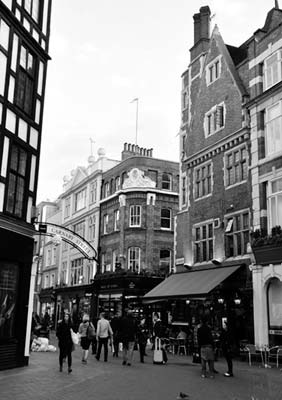
• After exploring Carnaby Street, walk back toward Great Marlborough Street, heading left (west) on Foubert’s Place (near the Shakespeare’s Head Pub). Then turn left again to continue strolling downhill along...
 Regent Street
Regent Street
You’re in the heart of London’s shopping neighborhood. By now, you may have noticed a sort of class divide among London shoppers.
Where the area near Oxford Circus was a bit low-rent, you’ve now entered London’s high-class, top-dollar boulevard. This street has wide sidewalks, fine architecture, and royal-family connections. Most of its shops call the Queen their landlord, as she owns much of the land here.
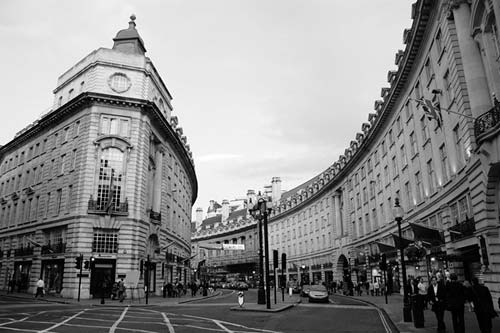
Once on Regent Street, follow the giddy kids to Hamleys (just downhill from Foubert’s Place, on the left at #188), Britain’s biggest toy store. In 2010 it marked its 250th anniversary of delighting children. Seven floors buzz with 50,000 toys, managed by a staff of 200. Employees, some dressed in playful costumes, give demos of the latest gadgets. It was here at Hamleys that the world first got to know London’s genteel Paddington Bear, and the less-genteel Build-a-Bear Workshop (now a fixture at malls everywhere).
On this stretch of Regent Street, fine bits of old English class dominate. Hackett (across from Hamleys at #193) is the place to go for preppy young English menswear. Mappin and Webb (on the left, at #132) is the Queen’s jeweler. Penhaligon’s (on the right, at #125) is the quintessential English perfumery, where royals shop (note the coat of arms at the door) for classic English scents like lavender and rose (fine sampler gift packs and free sniff samples). Once dowdy—it’s a clothier of the royal family—Burberry (on the corner past Penhaligon’s, at #121) is now hip.
• Regent Street arcs seductively into the ever-vibrant...
 Piccadilly Circus
Piccadilly Circus
Piccadilly Circus is where common tastes steamroll the elegance of Regent Street. Lillywhites (at the bottom of the square, near the Eros fountain) is a sports store popular as a place to buy the jersey of your favorite football (soccer) team. Farther left (at the start of Coventry Street) is Cool Britannia, a tacky palace of English kitsch and a Union Jack fantasy for anyone needing to buy a Brit-themed gift.
• From Piccadilly Circus, take a sharp right and wander down the busy...
 Piccadilly Street
Piccadilly Street
After a block on your left (at #203), escape from the frenzy of Piccadilly into the quiet of Waterstones, Europe’s largest bookshop and the flagship store of its widespread chain. Page through seven orderly floors. The fifth floor offers a hip bar with minimalist furniture and great views (see sidebar on here ).
Next you’ll pass Christopher Wren’s St. James’s Church (with free lunchtime concerts several days a week at 13:10—the current schedule is posted on its iron fence out front; for more details, see here ) and a tiny all-day flea market (antiques Tue 10:00-18:30, arts and crafts Wed-Sat 11:00-18:00, closed Sun-Mon). One block farther (on the left, at #181) is the Fortnum & Mason department store, which eschews the glitz of bigger stores and revels in understated old-school elegance. At the top of the hour the fancy clock on the facade is the scene of a low-key spectacle, as the venerable store’s founders—Fortnum and Mason—come out and bow to each other (best viewed from across the street). This reminds shoppers of the store’s humble beginnings 300 years ago, when it was started by these two footmen of Queen Anne; for more information, see here .
An elegant way to cap your shopping stroll (we’ll finish just a block from here) is with a traditional afternoon tea. While it’s a pricey ritual, many consider it an essential part of any London visit. My two favorite places in town for a traditional afternoon tea are within a block of here: Fortnum & Mason (with several restaurants and price ranges), and a block farther down Piccadilly Street, The Wolseley, the grand 1920s former showroom of a now defunct car manufacturer (where couples are allowed to split a £26.50 tea in sumptuous surroundings; on the left at #160). Nearby Brown’s Hotel serves a fancy £47.50 afternoon tea in its wood-paneled English Tea Room (33 Albemarle Street). For more details on these and other options, see “Taking Tea in London” on here . Another fancy spot for tea nearby is the original Ritz Hotel.
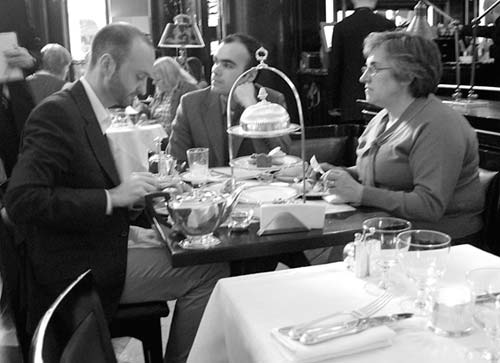
• But before we part ways, we’ll stroll a block south of big and busy Piccadilly Street. The Piccadilly Arcade leads to quiet...
 Jermyn Street
Jermyn Street
A statue of Beau Brummell, the ultimate dandy, meets you as if to say, “Within a block in either direction are numerous fine gentlemen’s shirtmakers and many other delightful small shops.” It was Brummell (1778-1840) who popularized the understated jacket-trousers-and-tie ensemble that men still wear today. As the quote on his statue reads, “To be truly elegant, one should not be noticed.”
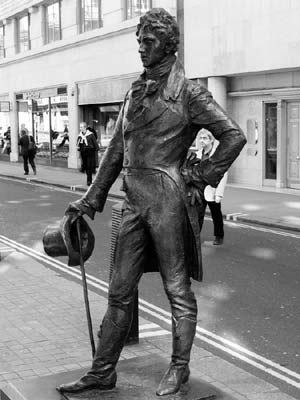
Stand by the statue and survey the landscape of man-scaping options: Bates Hats (#37, inside the Princess Arcade) still sells bowlers and top hats, as it has for a century. Turnbull & Asser (#71) has dressed Winston Churchill, Prince Charles, and James Bond with its “bespoke” (custom-made) shirts and suits. John Lobb (#88) has sold boots to Princes William and Harry. Tricker’s (#67) has been making shoes for the gentleman since the days of Beau Brummell. Taylor of Old Bond Street (#74), established in the mid-19th century, specializes in gentleman’s shaving and botanical products. After sauntering these few blocks, even the most weary traveler will leave Jermyn Street feeling (if not looking) more refined.
• Our walk is finished. From here, you have several nearby options. If you’re ready for teatime, cut back through the block to Piccadilly Street and the places I mentioned earlier.
Or, to head back to Piccadilly Circus (and its handy Tube stop), walk east down Jermyn Street, pausing at the classic perfume shop Floris (at #89) and at Paxton & Whitfields (#93), which has served exceptional cheese since 1797, with generous tastings. On the little Duke of York Street (behind St. James’s Church) is an old-fashioned barbershop called Geo. F. Trumper (selling top-quality shaving gear) and the classic Red Lion Pub. If all of this is just too elegant, dip into Piccadilly Circus’ Cool Britannia and buy some Union Jack underwear.